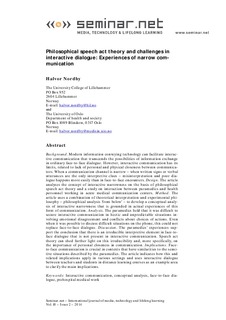Philosophical speech act theory and challenges in interactive dialogue: Experiences of narrow communication
Abstract
Background. Modern information conveying technology can facilitate interactive
communication that transcends the possibilities of information exchange
in ordinary face-to-face dialogue. However, interactive communication has its
limits, related to lack of personal and physical closeness between communicators.
When a communication channel is narrow – when written signs or verbal
utterances are the only interpretive clues – misinterpretation and poor dialogue
happens more easily than in face-to-face encounters. Design. The article
analyses the concept of interactive narrowness on the basis of philosophical
speech act theory and a study on interaction between paramedics and health
personnel working in acute medical communication centers. Method. The
article uses a combination of theoretical interpretation and experimental philosophy
– philosophical analysis ‘from below’ – to develop a conceptual analysis
of interactive narrowness that is grounded in actual experiences of this
form of communication. Analysis. The paramedics held that it was difficult to
secure interactive communication in hectic and unpredictable situations involving
emotional disagreement and conflicts about choices of actions. Even
when it was possible to discuss difficult situations on the phone, this could not
replace face-to-face dialogue. Discussion. The paramedics’ experiences support
the conclusion that there is an irreducible interpretive element in face-toface
dialogue that is not present in interactive communication. Speech act
theory can shed further light on this irreducibility and, more specifically, on
the importance of personal closeness in communication. Implications. Faceto-face
communication is crucial in contexts that have similarities to the sensitive
situations described by the paramedics. The article indicates how this and
related implications apply in various settings and uses interactive dialogue
between teachers and students in distance learning courses as an example area
to clarify the main implications.
